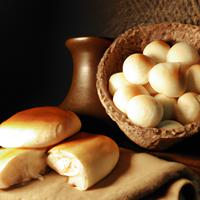
1 serving (28 grams) contains 80 calories, 2.5 grams of protein, 1.5 grams of fat, and 15.0 grams of carbohydrates.

Log this food in SnapCalorie

Nutrition Information
Calories |
678.0 | ||
|---|---|---|---|
% Daily Value* |
|||
| Total Fat | 12.7 g | 16% | |
| Saturated Fat | 4.2 g | 21% | |
| Polyunsaturated Fat | 0 g | ||
| Cholesterol | 0 mg | 0% | |
| Sodium | 1271.2 mg | 55% | |
| Total Carbohydrates | 127.1 g | 46% | |
| Dietary Fiber | 8.5 g | 30% | |
| Sugars | 16.9 g | ||
| protein | 21.2 g | 42% | |
| Vitamin D | 0 mcg | 0% | |
| Calcium | 84.7 mg | 6% | |
| Iron | 4.2 mg | 23% | |
| Potassium | 254.2 mg | 5% | |
* Percent Daily Values are based on a 2,000 calorie diet. Your daily values may be higher or lower depending on your calorie needs.
Food Attributes
Source of Calories
About Pandesal bread
Pandesal, a staple in Filipino cuisine, is a soft and mildly sweet bread roll made from basic ingredients like flour, yeast, sugar, salt, and water. Often enjoyed during breakfast or as a snack, its versatility allows for various fillings, such as butter, jam, or savory spreads. This bread is typically baked with a coating of breadcrumbs, giving it a lightly crisp exterior while maintaining a pillowy texture inside. While Pandesal provides a source of carbohydrates, it is relatively low in fat and can supply energy for daily activities. However, its nutritional profile can vary depending on the recipe or any added fillings, and some versions may contain refined flour and added sugar, which should be consumed in moderation. Pairing it with nutrient-rich spreads or sides can enhance its health benefits while maintaining its role as a beloved, comforting bread in Filipino households.



